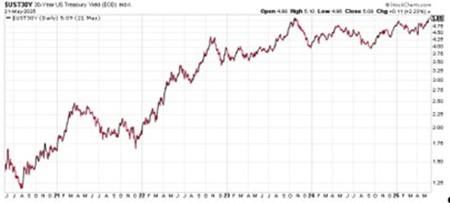
Sell Gold—No Wait, Don’t! -Doug Hornig, Contributing Editor The Gold Advisor
Accomplished fiction and nonfiction author and Paydirt Editor Doug Hornig has a message about those who are watching gold’s volatility and are tempted to trade it—and what the credit market is warning…
Panic
For a couple of weeks, Everyone’s Selling Gold was one of the dominant headlines in the financial sector—as the gold price tumbled by over three hundred dollars an ounce from its all-time high on April 22.
It was a mini-panic, and I had to chuckle. All that it really proved is that financial pundits and prognosticators need something to write about. Otherwise, you know, what would they do with their days?
For whatever it may be worth, most commentators ascribed gold’s meteoric rise since 2023 to concurrent global uncertainties of various economic and political kinds. Will wars be settled or rage on? Is the U.S. economy robust or on the brink of recession? Has inflation been tamed or about to shoot higher?
Obviously, those are questions which can be answered only with the passage of time. Sure, we’d all love to know in advance what happens next. But making a prediction, as Yogi Berra allegedly said, is difficult, especially about the future.
What is Gold, Really?
There’s nothing morally wrong with being an in-and-out gold trader, if that’s your thing. But if you have a longer perspective, buying and selling gold on transitory fear and greed can be hazardous to your financial well-being.
I hold physical gold because it’s a store of value. I don’t play its ups and downs as if it was Nvidia stock. I’ve never sold any of my ounces, and why would I? They have the same purchasing power they did when gold hit its former inflation-adjusted high in 1980. That’s a 45-year stretch during which gold was stable while the U.S. dollar shed 75% of its value. That’s inflation-proofing at its finest.
In fact, the safest bet you could possibly make is that 50 years from now gold will still be around and still be considered money. The dollar may not be, at least in its current form—an intriguing subject for another day.
For now, consider that gold had a near-200% runup in price from its 2023 low to this April. Why? All of the factors listed above played in, with probably a number of others. The common denominator is uncertainty. The more anxious people are, they more they seek gold as a safe haven. And as fear ebbs, they tend to ride with the herd, back into the stock market and other assets that dangle the possibility of higher returns.
All a matter of perception, isn’t it? And what we humans think we perceive, as we strive to make sense of a chaotic world, is notoriously untrustworthy.
So that is the wrong way to look at gold. It should always be appreciated as the premier store of value, and steadily appreciate.
But in the short term it isn’t and doesn’t. Its price is subject to the same emotions and perceptions as any other asset. Moreover, if there’s a market truism, it’s that no asset goes up in a straight line forever. Gold’s big rally meant it was due for an inevitable retracement.
In reality, the decline wasn’t all that dramatic. At its bottom, gold was down less than 9% from its all-time high. That’s not even what stock market pundits would consider a “correction.”
Then the trend reversed. As I write in late May, gold has already clawed back about 35% of its paper “losses.”
The Uncertainty Principle
There are plenty of available explanations for this, but let’s stick with the general principle that demand rises with uncertainty. That being the case, there is one particular source of anxiety that may have figured into gold’s turnaround. While I believe gold buyers are beginning to feel it, I don’t think it is getting the wider attention it deserves.
It’s all about credit.
The creditworthiness of corporations and governments is determined by the “Big 3” agencies: S&P, Fitch and Moody’s. They all issue ratings of an entity’s debt, from best to worst. Nomenclature differs slightly, but for Moody’s, credit ranges from Aaa (prime, or virtually no risk), all the way down to C (junk, virtually worthless). There are 21 different categories as you descend the scale.
Bond purchasers are choosy. They pay attention to credit ratings. A downgrade by one of the agencies is significant; by three downgrades, it’s a trend. It means that risk of default has gone up, and that the interest offered by the issuer should rise in compensation.
This applies to countries as well as companies. It matters. Although the Big 3 agencies’ reputations got a bit tarnished by questionable dealings during the Great Financial Crisis of 2008, they are still the ones who are trusted with providing the best assessment of a government’s creditworthiness.
In 1917, Moody’s initiated coverage of U.S. federal debt by granting the country an Aaa rating. On Friday, May 16, the agency issued its first downgrade in over a century, to Aa1, following a November 2023 assessment that revised its outlook for the Aaa rating from “stable” to “negative.” Moody’s was the last holdout, with both S&P (2011) and Fitch (2023) having dropped their ratings earlier.
What does this unanimous loss of a perfect credit rating mean?
Put simply, confidence in the creditworthiness of the United States is the foundation upon which global financial stability rests. Downgrading it a notch doesn’t mean that foundation is crumbling. But it does reveal a crack in the masonry. It reflects a non-trivial concern about the country’s long-term ability to live up to its obligations.
This was once unthinkable. But it’s a warning from the financial establishment that the U.S. government should probably consider some structural changes to the way it does business.
And What Happens Next?
The consequences of this change are unpredictable. Perhaps they’ll be negligible. We can hope. But domestic bond investors could demand slightly higher interest rates on U.S. Treasuries. That in turn would drive up interest payments on the national debt, which are already dangerously high. And it could have a ripple effect on everything from credit cards to auto loans and home mortgages. All of which might slow a relatively fragile economy.
International ramifications could be considerable. Foreign governments and central banks have been diversifying away from the dollar over the past couple of years. That could accelerate, which would be a huge deal as they own nearly half of our government debt.
Should foreign-held Treasuries hit the marketplace in quantity, that would add a further escalation to rising interest rates. As buyers dwindled, the Fed would be obligated to print dollars to absorb the Treasuries into its balance sheet. A flood of new currency = substantial inflation, and probably a serious recession. At the very worst, there could be a 2008-style liquidity crisis.
Will any of this happen? I have no idea. But the place to watch is the bond market. On May 21 the yield on the 30-year pushed above 5%, which has been a key psychological bellwether for declining interest in US debt.
While it’s best not to get too caught up in day-to-day fluctuations like this, we are indisputably in the midst of a period of great volatility, for all markets.
Eyes on the Prize
The important thing to keep in mind is that volatility is not the enemy. Gold is the ultimate stabilizing force. If it were to blast its way to $5,000/oz.—as some who pretend to know the future contend it will—then great. Those who foresaw it can thump their Nostradamus chests while we enjoy the flush of greatly heightened buying power.
While I certainly don’t expect it, the gold price could slip into an extended, temporary downtrend. Which I’d celebrate. That simply makes for a buying opportunity, such as now exists with most mining stocks, whose valuations are far from reflective of even the current gold price.
If you’d like to capitalize on those low valuations, your timing is ideal. Some mining stocks have started to move in a big way—but many are still on the launchpad, including new opportunities we come across. See what Jeff is personally buying and the 6 stocks he just listed as the best Summer Paydirt Speculations, ones with the shortest fuse.
Courtesy of the Gold Advisor
MORE or "UNCATEGORIZED"
Doubleview Extends High-Grade Domains at Hat: H099 Returns 438m of 0.40% CuEq Including 52m of 1.02% CuEq, Expanding Mineralization Envelope Around Conceptual Pit Vertically and Laterally
Doubleview Gold Corp. (TSX-V: DBG) (OTCQB: DBLVF) (FSE: 1D4) is pleased to announce assay results f... READ MORE
Cosa Closes Upsized C$7.5 Million Private Placement
Cosa Resources Corp. (TSX-V: COSA) (OTCQB: COSAF) (FSE: SSKU) is pleased to announce that it ... READ MORE
Americas Gold and Silver Closes US$132.25 Million Bought Deal Financing
Americas Gold and Silver Corporation (TSX: USA) (NYSE American: USAS) is pleased to report that it h... READ MORE
1911 Gold Closes C$23 Million "Best Efforts" Life Offering & Private Placement and Provides Corporate Updates
1911 Gold Corporation (TSX-V: AUMB) (FRA: 2KY) is pleased to announce that it has completed its prev... READ MORE
Endeavour Silver Completes US$350 Million Offering of Convertible Senior Notes
Endeavour Silver Corp. (NYSE: EXK) (TSX: EDR) announced today the closing of its previously announce... READ MORE














